Marks & Spencer Strategic Management: Analysis & Strategy Plan
VerifiedAdded on 2023/06/10
|14
|4382
|440
Report
AI Summary
This report provides a strategic analysis of Marks and Spencer (M&S), a major UK retailer, focusing on its business and corporate strategies. It covers environmental analysis using PESTLE, resource and competence analysis highlighting physical and organizational resources, and core competencies. The report details M&S's mission to offer quality products and good value, emphasizing its vertical incorporation, fast fashion model, and customer-centric approach. It discusses resource implications, including prime locations, attractive window displays, and market-oriented strategies. The analysis includes a strategic plan focused on sustainability, waste reduction, and the use of ecological fabrics. Finally, the report touches upon strategy implementation, emphasizing the importance of employee education and innovative production strategies to maintain a competitive edge in the retail industry. Desklib offers this report and many more to aid students in their studies.
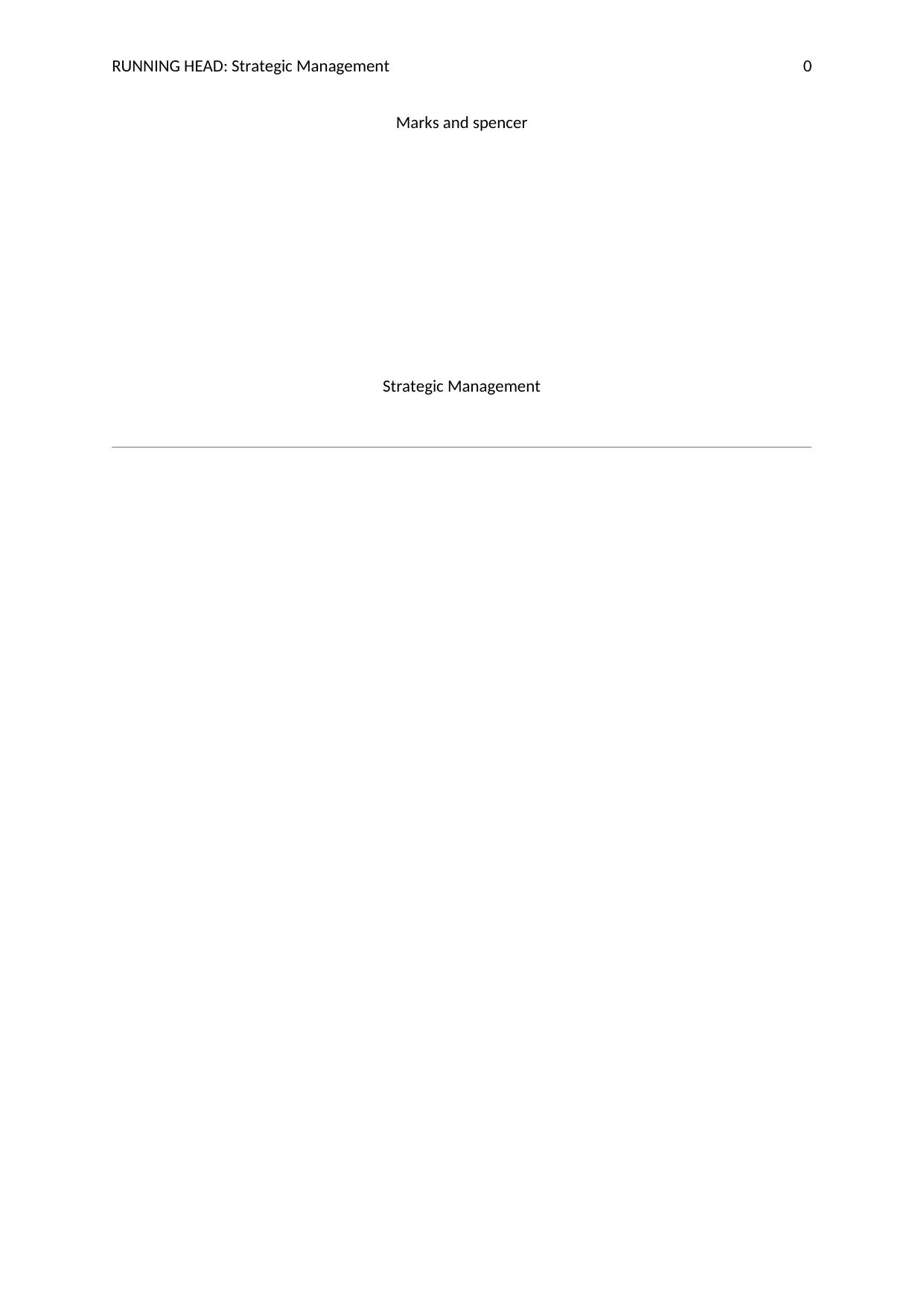
RUNNING HEAD: Strategic Management 0
Marks and spencer
Strategic Management
Marks and spencer
Strategic Management
Paraphrase This Document
Need a fresh take? Get an instant paraphrase of this document with our AI Paraphraser
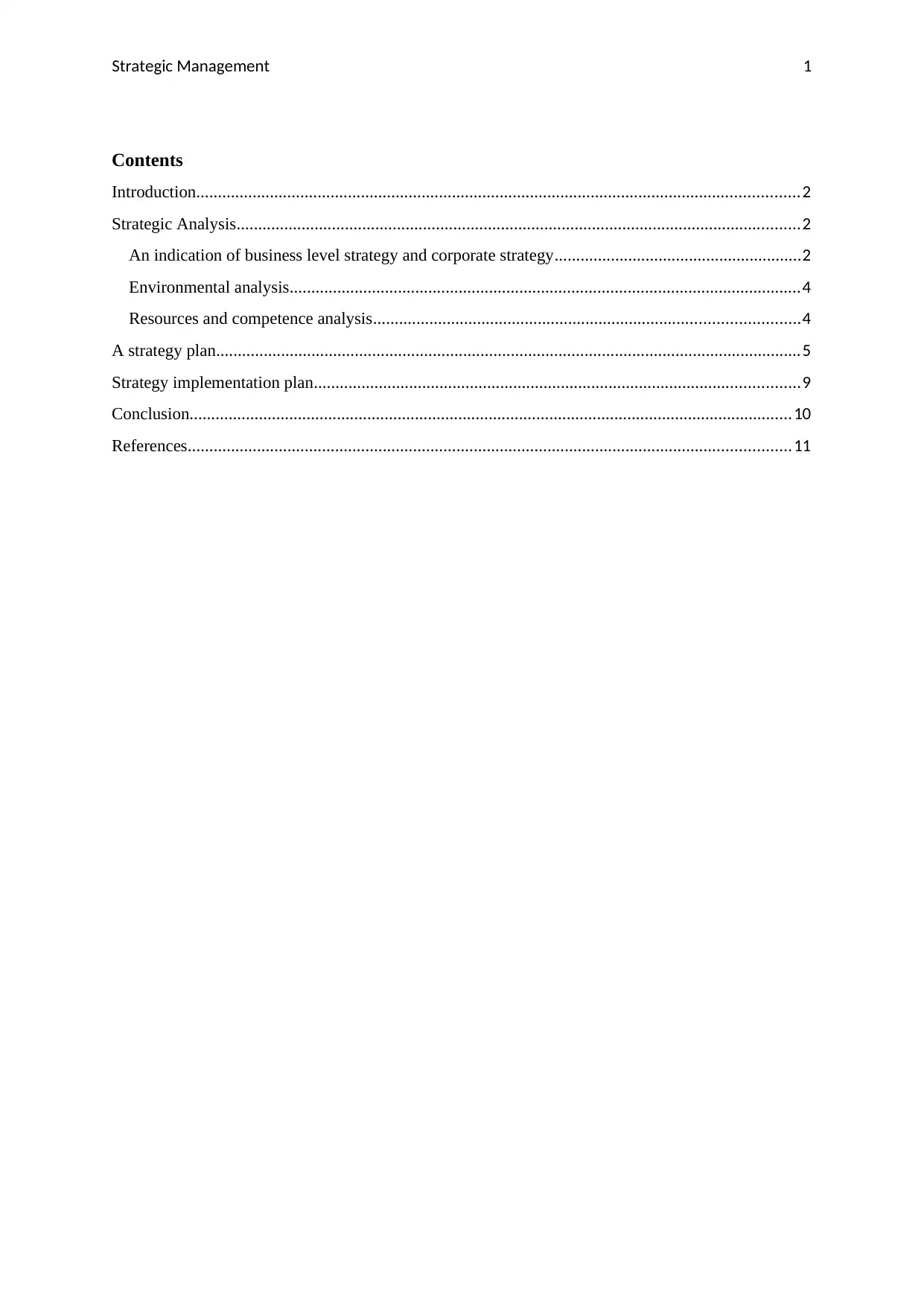
Strategic Management 1
Contents
Introduction...........................................................................................................................................2
Strategic Analysis..................................................................................................................................2
An indication of business level strategy and corporate strategy.........................................................2
Environmental analysis......................................................................................................................4
Resources and competence analysis..................................................................................................4
A strategy plan.......................................................................................................................................5
Strategy implementation plan................................................................................................................9
Conclusion...........................................................................................................................................10
References...........................................................................................................................................11
Contents
Introduction...........................................................................................................................................2
Strategic Analysis..................................................................................................................................2
An indication of business level strategy and corporate strategy.........................................................2
Environmental analysis......................................................................................................................4
Resources and competence analysis..................................................................................................4
A strategy plan.......................................................................................................................................5
Strategy implementation plan................................................................................................................9
Conclusion...........................................................................................................................................10
References...........................................................................................................................................11
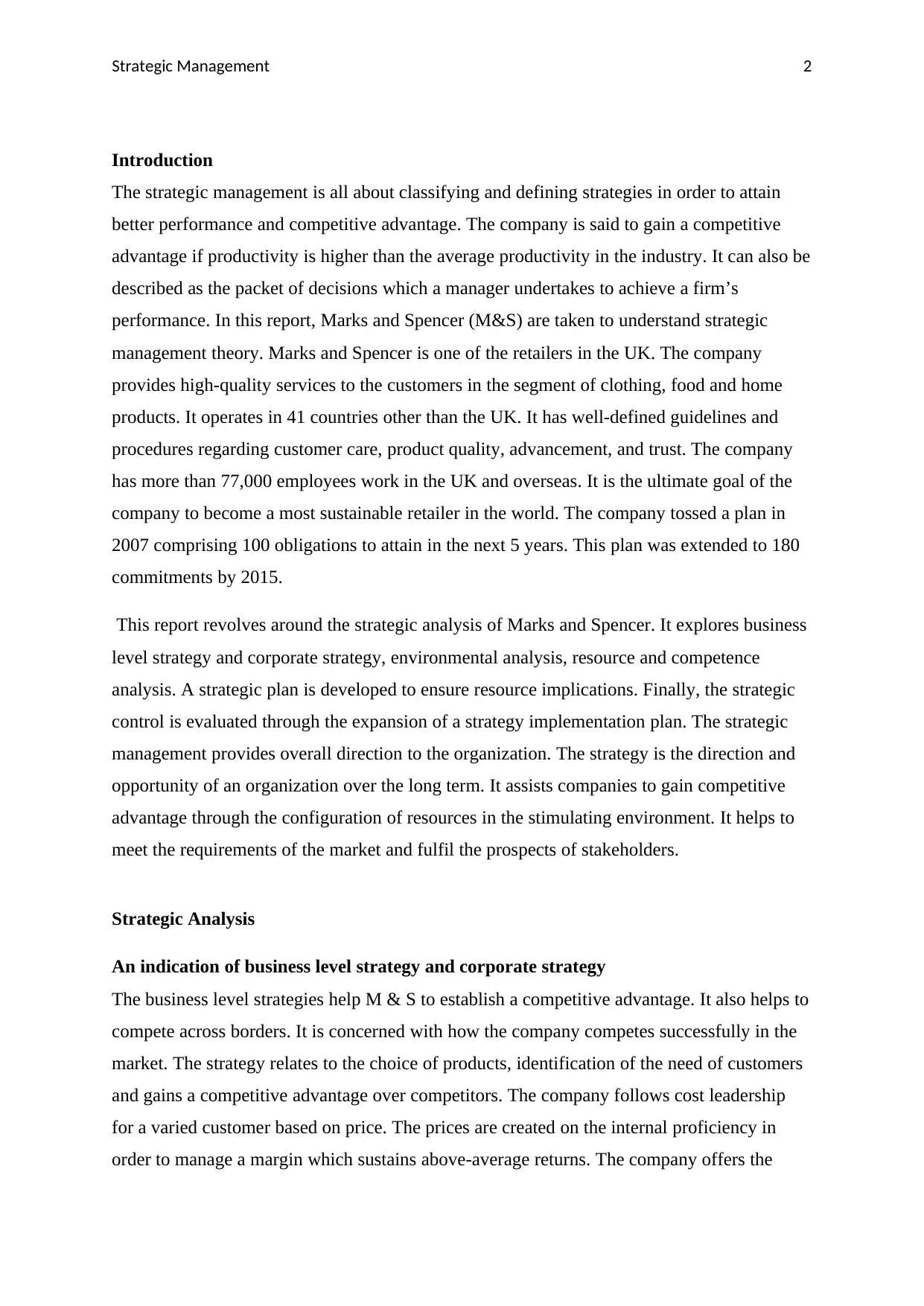
Strategic Management 2
Introduction
The strategic management is all about classifying and defining strategies in order to attain
better performance and competitive advantage. The company is said to gain a competitive
advantage if productivity is higher than the average productivity in the industry. It can also be
described as the packet of decisions which a manager undertakes to achieve a firm’s
performance. In this report, Marks and Spencer (M&S) are taken to understand strategic
management theory. Marks and Spencer is one of the retailers in the UK. The company
provides high-quality services to the customers in the segment of clothing, food and home
products. It operates in 41 countries other than the UK. It has well-defined guidelines and
procedures regarding customer care, product quality, advancement, and trust. The company
has more than 77,000 employees work in the UK and overseas. It is the ultimate goal of the
company to become a most sustainable retailer in the world. The company tossed a plan in
2007 comprising 100 obligations to attain in the next 5 years. This plan was extended to 180
commitments by 2015.
This report revolves around the strategic analysis of Marks and Spencer. It explores business
level strategy and corporate strategy, environmental analysis, resource and competence
analysis. A strategic plan is developed to ensure resource implications. Finally, the strategic
control is evaluated through the expansion of a strategy implementation plan. The strategic
management provides overall direction to the organization. The strategy is the direction and
opportunity of an organization over the long term. It assists companies to gain competitive
advantage through the configuration of resources in the stimulating environment. It helps to
meet the requirements of the market and fulfil the prospects of stakeholders.
Strategic Analysis
An indication of business level strategy and corporate strategy
The business level strategies help M & S to establish a competitive advantage. It also helps to
compete across borders. It is concerned with how the company competes successfully in the
market. The strategy relates to the choice of products, identification of the need of customers
and gains a competitive advantage over competitors. The company follows cost leadership
for a varied customer based on price. The prices are created on the internal proficiency in
order to manage a margin which sustains above-average returns. The company offers the
Introduction
The strategic management is all about classifying and defining strategies in order to attain
better performance and competitive advantage. The company is said to gain a competitive
advantage if productivity is higher than the average productivity in the industry. It can also be
described as the packet of decisions which a manager undertakes to achieve a firm’s
performance. In this report, Marks and Spencer (M&S) are taken to understand strategic
management theory. Marks and Spencer is one of the retailers in the UK. The company
provides high-quality services to the customers in the segment of clothing, food and home
products. It operates in 41 countries other than the UK. It has well-defined guidelines and
procedures regarding customer care, product quality, advancement, and trust. The company
has more than 77,000 employees work in the UK and overseas. It is the ultimate goal of the
company to become a most sustainable retailer in the world. The company tossed a plan in
2007 comprising 100 obligations to attain in the next 5 years. This plan was extended to 180
commitments by 2015.
This report revolves around the strategic analysis of Marks and Spencer. It explores business
level strategy and corporate strategy, environmental analysis, resource and competence
analysis. A strategic plan is developed to ensure resource implications. Finally, the strategic
control is evaluated through the expansion of a strategy implementation plan. The strategic
management provides overall direction to the organization. The strategy is the direction and
opportunity of an organization over the long term. It assists companies to gain competitive
advantage through the configuration of resources in the stimulating environment. It helps to
meet the requirements of the market and fulfil the prospects of stakeholders.
Strategic Analysis
An indication of business level strategy and corporate strategy
The business level strategies help M & S to establish a competitive advantage. It also helps to
compete across borders. It is concerned with how the company competes successfully in the
market. The strategy relates to the choice of products, identification of the need of customers
and gains a competitive advantage over competitors. The company follows cost leadership
for a varied customer based on price. The prices are created on the internal proficiency in
order to manage a margin which sustains above-average returns. The company offers the
⊘ This is a preview!⊘
Do you want full access?
Subscribe today to unlock all pages.

Trusted by 1+ million students worldwide
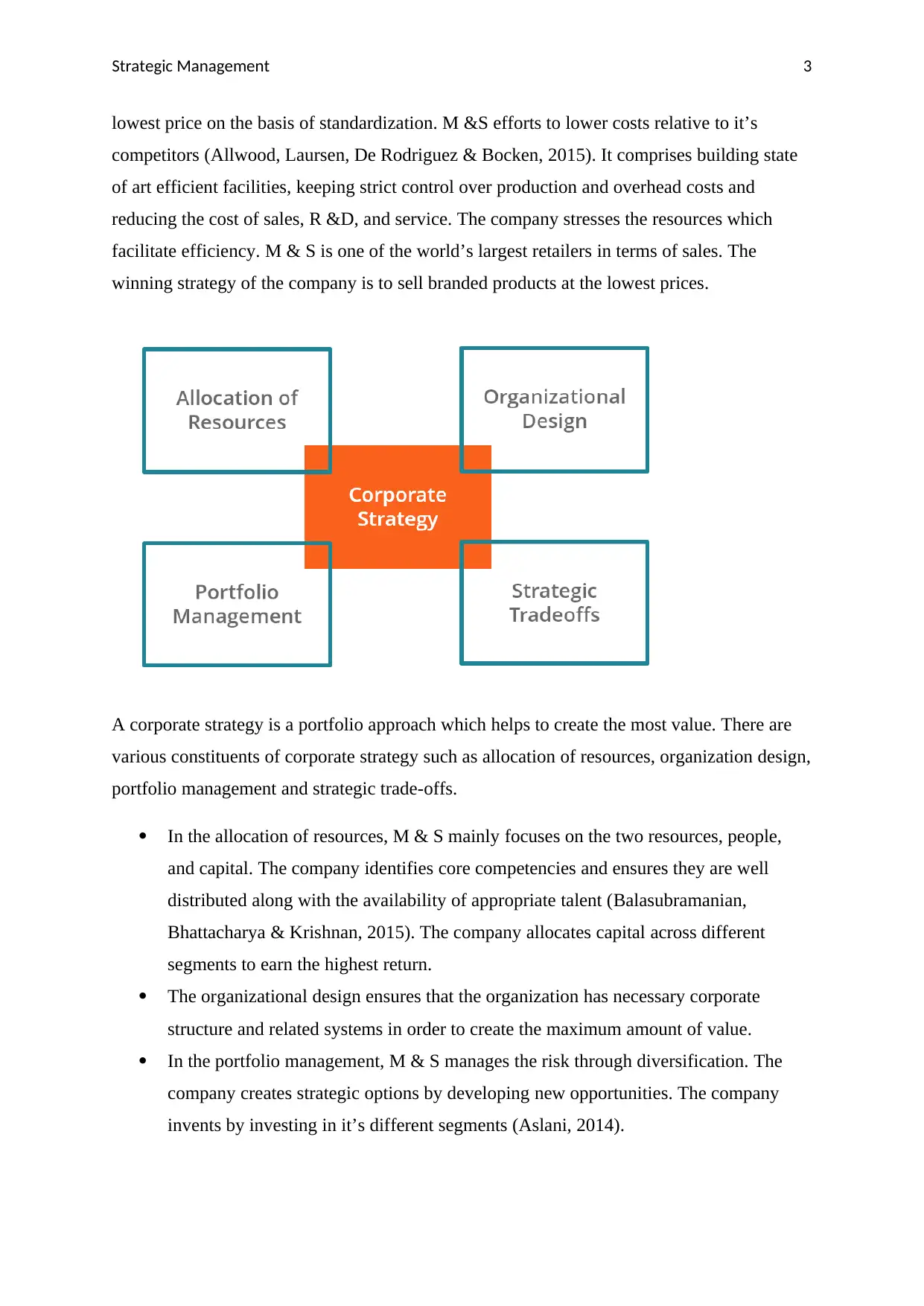
Strategic Management 3
lowest price on the basis of standardization. M &S efforts to lower costs relative to it’s
competitors (Allwood, Laursen, De Rodriguez & Bocken, 2015). It comprises building state
of art efficient facilities, keeping strict control over production and overhead costs and
reducing the cost of sales, R &D, and service. The company stresses the resources which
facilitate efficiency. M & S is one of the world’s largest retailers in terms of sales. The
winning strategy of the company is to sell branded products at the lowest prices.
A corporate strategy is a portfolio approach which helps to create the most value. There are
various constituents of corporate strategy such as allocation of resources, organization design,
portfolio management and strategic trade-offs.
In the allocation of resources, M & S mainly focuses on the two resources, people,
and capital. The company identifies core competencies and ensures they are well
distributed along with the availability of appropriate talent (Balasubramanian,
Bhattacharya & Krishnan, 2015). The company allocates capital across different
segments to earn the highest return.
The organizational design ensures that the organization has necessary corporate
structure and related systems in order to create the maximum amount of value.
In the portfolio management, M & S manages the risk through diversification. The
company creates strategic options by developing new opportunities. The company
invents by investing in it’s different segments (Aslani, 2014).
lowest price on the basis of standardization. M &S efforts to lower costs relative to it’s
competitors (Allwood, Laursen, De Rodriguez & Bocken, 2015). It comprises building state
of art efficient facilities, keeping strict control over production and overhead costs and
reducing the cost of sales, R &D, and service. The company stresses the resources which
facilitate efficiency. M & S is one of the world’s largest retailers in terms of sales. The
winning strategy of the company is to sell branded products at the lowest prices.
A corporate strategy is a portfolio approach which helps to create the most value. There are
various constituents of corporate strategy such as allocation of resources, organization design,
portfolio management and strategic trade-offs.
In the allocation of resources, M & S mainly focuses on the two resources, people,
and capital. The company identifies core competencies and ensures they are well
distributed along with the availability of appropriate talent (Balasubramanian,
Bhattacharya & Krishnan, 2015). The company allocates capital across different
segments to earn the highest return.
The organizational design ensures that the organization has necessary corporate
structure and related systems in order to create the maximum amount of value.
In the portfolio management, M & S manages the risk through diversification. The
company creates strategic options by developing new opportunities. The company
invents by investing in it’s different segments (Aslani, 2014).
Paraphrase This Document
Need a fresh take? Get an instant paraphrase of this document with our AI Paraphraser
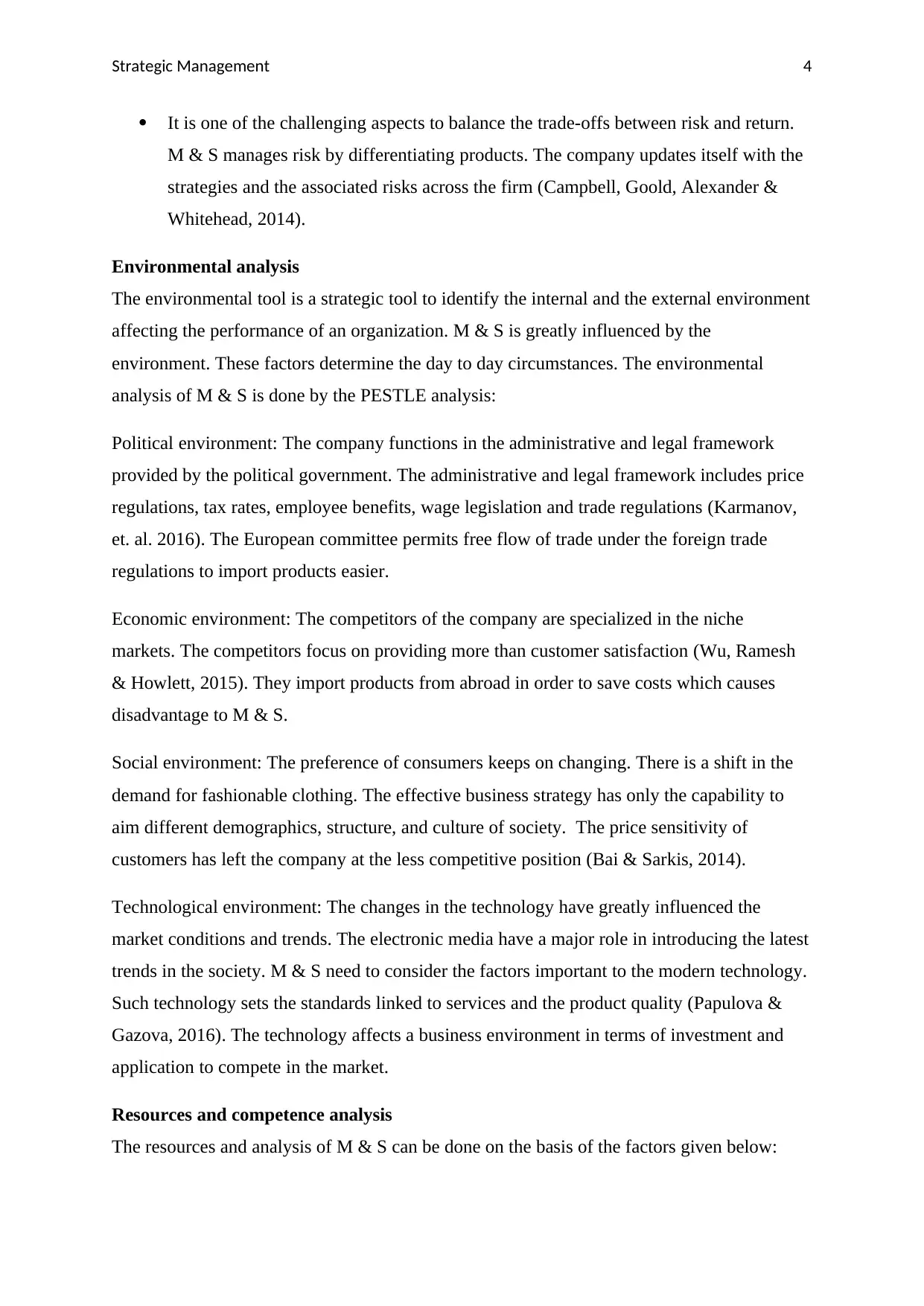
Strategic Management 4
It is one of the challenging aspects to balance the trade-offs between risk and return.
M & S manages risk by differentiating products. The company updates itself with the
strategies and the associated risks across the firm (Campbell, Goold, Alexander &
Whitehead, 2014).
Environmental analysis
The environmental tool is a strategic tool to identify the internal and the external environment
affecting the performance of an organization. M & S is greatly influenced by the
environment. These factors determine the day to day circumstances. The environmental
analysis of M & S is done by the PESTLE analysis:
Political environment: The company functions in the administrative and legal framework
provided by the political government. The administrative and legal framework includes price
regulations, tax rates, employee benefits, wage legislation and trade regulations (Karmanov,
et. al. 2016). The European committee permits free flow of trade under the foreign trade
regulations to import products easier.
Economic environment: The competitors of the company are specialized in the niche
markets. The competitors focus on providing more than customer satisfaction (Wu, Ramesh
& Howlett, 2015). They import products from abroad in order to save costs which causes
disadvantage to M & S.
Social environment: The preference of consumers keeps on changing. There is a shift in the
demand for fashionable clothing. The effective business strategy has only the capability to
aim different demographics, structure, and culture of society. The price sensitivity of
customers has left the company at the less competitive position (Bai & Sarkis, 2014).
Technological environment: The changes in the technology have greatly influenced the
market conditions and trends. The electronic media have a major role in introducing the latest
trends in the society. M & S need to consider the factors important to the modern technology.
Such technology sets the standards linked to services and the product quality (Papulova &
Gazova, 2016). The technology affects a business environment in terms of investment and
application to compete in the market.
Resources and competence analysis
The resources and analysis of M & S can be done on the basis of the factors given below:
It is one of the challenging aspects to balance the trade-offs between risk and return.
M & S manages risk by differentiating products. The company updates itself with the
strategies and the associated risks across the firm (Campbell, Goold, Alexander &
Whitehead, 2014).
Environmental analysis
The environmental tool is a strategic tool to identify the internal and the external environment
affecting the performance of an organization. M & S is greatly influenced by the
environment. These factors determine the day to day circumstances. The environmental
analysis of M & S is done by the PESTLE analysis:
Political environment: The company functions in the administrative and legal framework
provided by the political government. The administrative and legal framework includes price
regulations, tax rates, employee benefits, wage legislation and trade regulations (Karmanov,
et. al. 2016). The European committee permits free flow of trade under the foreign trade
regulations to import products easier.
Economic environment: The competitors of the company are specialized in the niche
markets. The competitors focus on providing more than customer satisfaction (Wu, Ramesh
& Howlett, 2015). They import products from abroad in order to save costs which causes
disadvantage to M & S.
Social environment: The preference of consumers keeps on changing. There is a shift in the
demand for fashionable clothing. The effective business strategy has only the capability to
aim different demographics, structure, and culture of society. The price sensitivity of
customers has left the company at the less competitive position (Bai & Sarkis, 2014).
Technological environment: The changes in the technology have greatly influenced the
market conditions and trends. The electronic media have a major role in introducing the latest
trends in the society. M & S need to consider the factors important to the modern technology.
Such technology sets the standards linked to services and the product quality (Papulova &
Gazova, 2016). The technology affects a business environment in terms of investment and
application to compete in the market.
Resources and competence analysis
The resources and analysis of M & S can be done on the basis of the factors given below:
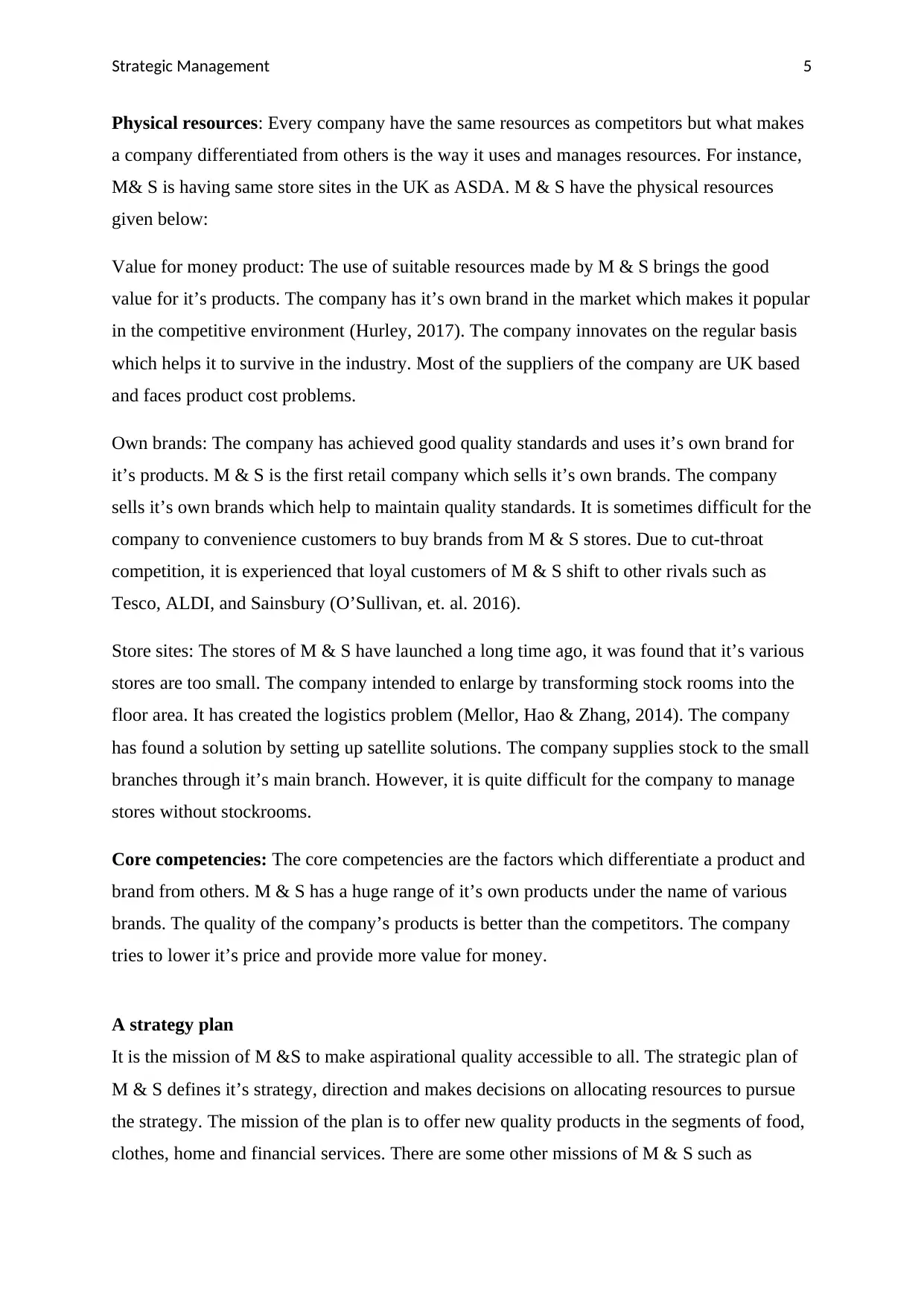
Strategic Management 5
Physical resources: Every company have the same resources as competitors but what makes
a company differentiated from others is the way it uses and manages resources. For instance,
M& S is having same store sites in the UK as ASDA. M & S have the physical resources
given below:
Value for money product: The use of suitable resources made by M & S brings the good
value for it’s products. The company has it’s own brand in the market which makes it popular
in the competitive environment (Hurley, 2017). The company innovates on the regular basis
which helps it to survive in the industry. Most of the suppliers of the company are UK based
and faces product cost problems.
Own brands: The company has achieved good quality standards and uses it’s own brand for
it’s products. M & S is the first retail company which sells it’s own brands. The company
sells it’s own brands which help to maintain quality standards. It is sometimes difficult for the
company to convenience customers to buy brands from M & S stores. Due to cut-throat
competition, it is experienced that loyal customers of M & S shift to other rivals such as
Tesco, ALDI, and Sainsbury (O’Sullivan, et. al. 2016).
Store sites: The stores of M & S have launched a long time ago, it was found that it’s various
stores are too small. The company intended to enlarge by transforming stock rooms into the
floor area. It has created the logistics problem (Mellor, Hao & Zhang, 2014). The company
has found a solution by setting up satellite solutions. The company supplies stock to the small
branches through it’s main branch. However, it is quite difficult for the company to manage
stores without stockrooms.
Core competencies: The core competencies are the factors which differentiate a product and
brand from others. M & S has a huge range of it’s own products under the name of various
brands. The quality of the company’s products is better than the competitors. The company
tries to lower it’s price and provide more value for money.
A strategy plan
It is the mission of M &S to make aspirational quality accessible to all. The strategic plan of
M & S defines it’s strategy, direction and makes decisions on allocating resources to pursue
the strategy. The mission of the plan is to offer new quality products in the segments of food,
clothes, home and financial services. There are some other missions of M & S such as
Physical resources: Every company have the same resources as competitors but what makes
a company differentiated from others is the way it uses and manages resources. For instance,
M& S is having same store sites in the UK as ASDA. M & S have the physical resources
given below:
Value for money product: The use of suitable resources made by M & S brings the good
value for it’s products. The company has it’s own brand in the market which makes it popular
in the competitive environment (Hurley, 2017). The company innovates on the regular basis
which helps it to survive in the industry. Most of the suppliers of the company are UK based
and faces product cost problems.
Own brands: The company has achieved good quality standards and uses it’s own brand for
it’s products. M & S is the first retail company which sells it’s own brands. The company
sells it’s own brands which help to maintain quality standards. It is sometimes difficult for the
company to convenience customers to buy brands from M & S stores. Due to cut-throat
competition, it is experienced that loyal customers of M & S shift to other rivals such as
Tesco, ALDI, and Sainsbury (O’Sullivan, et. al. 2016).
Store sites: The stores of M & S have launched a long time ago, it was found that it’s various
stores are too small. The company intended to enlarge by transforming stock rooms into the
floor area. It has created the logistics problem (Mellor, Hao & Zhang, 2014). The company
has found a solution by setting up satellite solutions. The company supplies stock to the small
branches through it’s main branch. However, it is quite difficult for the company to manage
stores without stockrooms.
Core competencies: The core competencies are the factors which differentiate a product and
brand from others. M & S has a huge range of it’s own products under the name of various
brands. The quality of the company’s products is better than the competitors. The company
tries to lower it’s price and provide more value for money.
A strategy plan
It is the mission of M &S to make aspirational quality accessible to all. The strategic plan of
M & S defines it’s strategy, direction and makes decisions on allocating resources to pursue
the strategy. The mission of the plan is to offer new quality products in the segments of food,
clothes, home and financial services. There are some other missions of M & S such as
⊘ This is a preview!⊘
Do you want full access?
Subscribe today to unlock all pages.

Trusted by 1+ million students worldwide
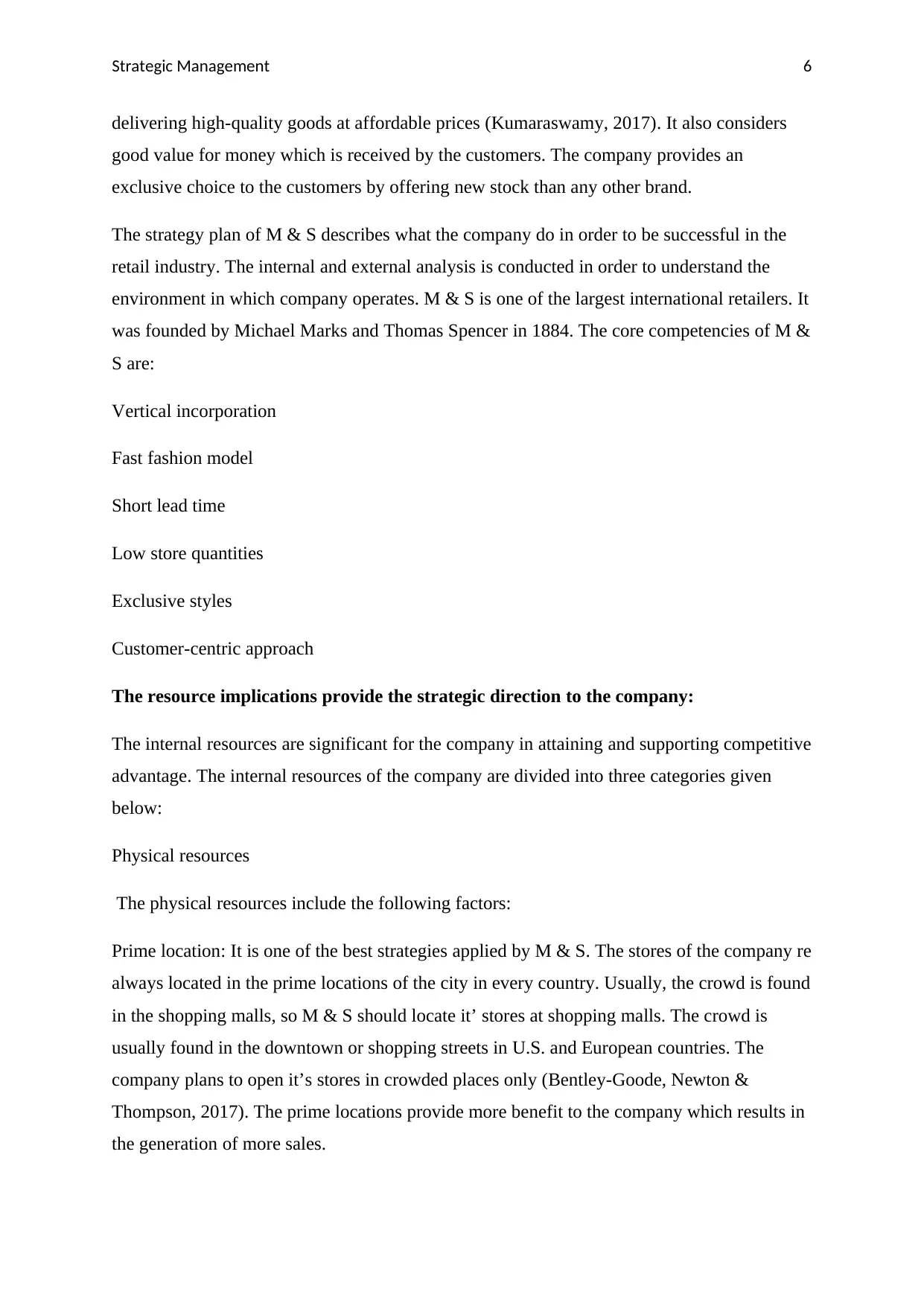
Strategic Management 6
delivering high-quality goods at affordable prices (Kumaraswamy, 2017). It also considers
good value for money which is received by the customers. The company provides an
exclusive choice to the customers by offering new stock than any other brand.
The strategy plan of M & S describes what the company do in order to be successful in the
retail industry. The internal and external analysis is conducted in order to understand the
environment in which company operates. M & S is one of the largest international retailers. It
was founded by Michael Marks and Thomas Spencer in 1884. The core competencies of M &
S are:
Vertical incorporation
Fast fashion model
Short lead time
Low store quantities
Exclusive styles
Customer-centric approach
The resource implications provide the strategic direction to the company:
The internal resources are significant for the company in attaining and supporting competitive
advantage. The internal resources of the company are divided into three categories given
below:
Physical resources
The physical resources include the following factors:
Prime location: It is one of the best strategies applied by M & S. The stores of the company re
always located in the prime locations of the city in every country. Usually, the crowd is found
in the shopping malls, so M & S should locate it’ stores at shopping malls. The crowd is
usually found in the downtown or shopping streets in U.S. and European countries. The
company plans to open it’s stores in crowded places only (Bentley-Goode, Newton &
Thompson, 2017). The prime locations provide more benefit to the company which results in
the generation of more sales.
delivering high-quality goods at affordable prices (Kumaraswamy, 2017). It also considers
good value for money which is received by the customers. The company provides an
exclusive choice to the customers by offering new stock than any other brand.
The strategy plan of M & S describes what the company do in order to be successful in the
retail industry. The internal and external analysis is conducted in order to understand the
environment in which company operates. M & S is one of the largest international retailers. It
was founded by Michael Marks and Thomas Spencer in 1884. The core competencies of M &
S are:
Vertical incorporation
Fast fashion model
Short lead time
Low store quantities
Exclusive styles
Customer-centric approach
The resource implications provide the strategic direction to the company:
The internal resources are significant for the company in attaining and supporting competitive
advantage. The internal resources of the company are divided into three categories given
below:
Physical resources
The physical resources include the following factors:
Prime location: It is one of the best strategies applied by M & S. The stores of the company re
always located in the prime locations of the city in every country. Usually, the crowd is found
in the shopping malls, so M & S should locate it’ stores at shopping malls. The crowd is
usually found in the downtown or shopping streets in U.S. and European countries. The
company plans to open it’s stores in crowded places only (Bentley-Goode, Newton &
Thompson, 2017). The prime locations provide more benefit to the company which results in
the generation of more sales.
Paraphrase This Document
Need a fresh take? Get an instant paraphrase of this document with our AI Paraphraser
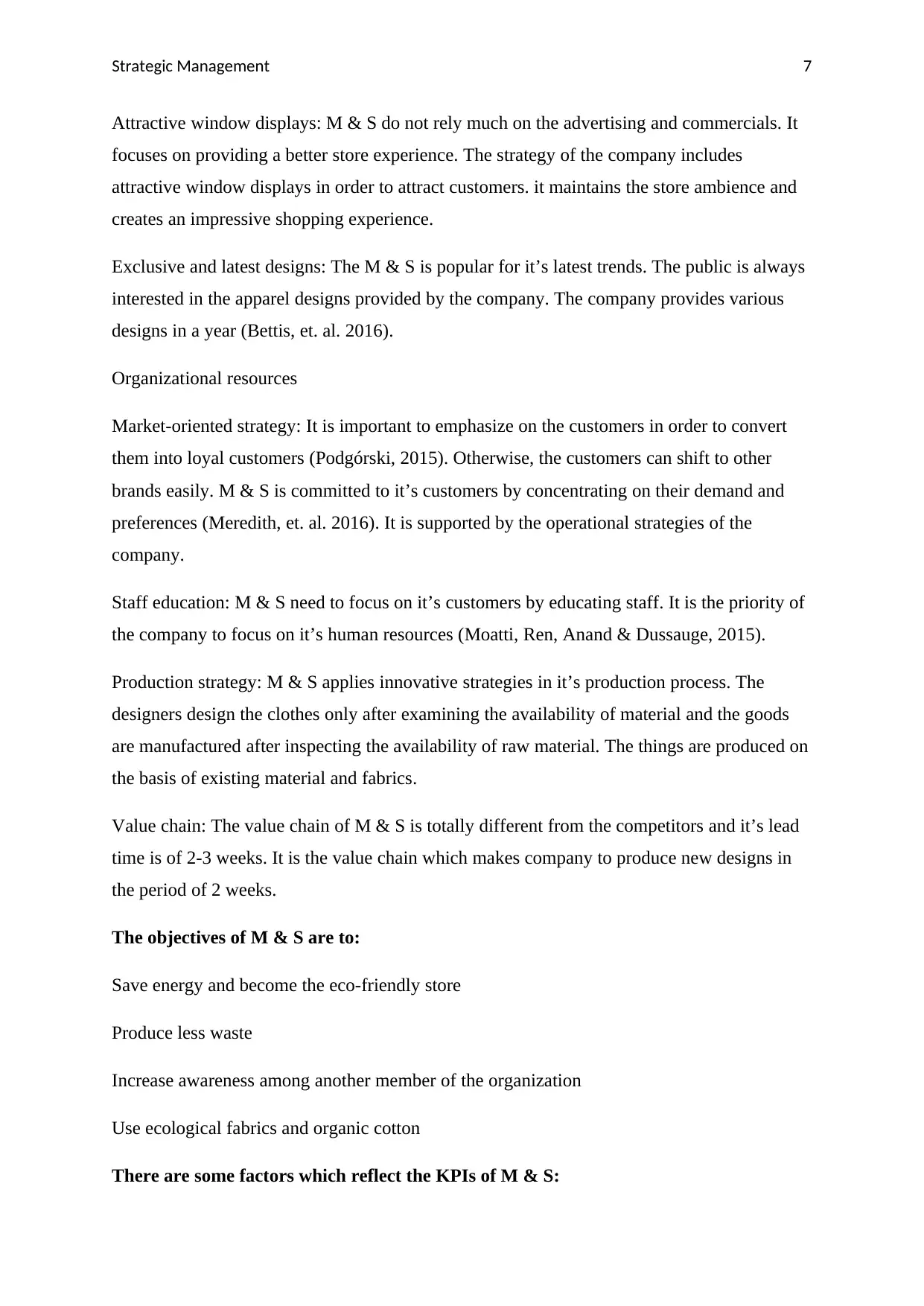
Strategic Management 7
Attractive window displays: M & S do not rely much on the advertising and commercials. It
focuses on providing a better store experience. The strategy of the company includes
attractive window displays in order to attract customers. it maintains the store ambience and
creates an impressive shopping experience.
Exclusive and latest designs: The M & S is popular for it’s latest trends. The public is always
interested in the apparel designs provided by the company. The company provides various
designs in a year (Bettis, et. al. 2016).
Organizational resources
Market-oriented strategy: It is important to emphasize on the customers in order to convert
them into loyal customers (Podgórski, 2015). Otherwise, the customers can shift to other
brands easily. M & S is committed to it’s customers by concentrating on their demand and
preferences (Meredith, et. al. 2016). It is supported by the operational strategies of the
company.
Staff education: M & S need to focus on it’s customers by educating staff. It is the priority of
the company to focus on it’s human resources (Moatti, Ren, Anand & Dussauge, 2015).
Production strategy: M & S applies innovative strategies in it’s production process. The
designers design the clothes only after examining the availability of material and the goods
are manufactured after inspecting the availability of raw material. The things are produced on
the basis of existing material and fabrics.
Value chain: The value chain of M & S is totally different from the competitors and it’s lead
time is of 2-3 weeks. It is the value chain which makes company to produce new designs in
the period of 2 weeks.
The objectives of M & S are to:
Save energy and become the eco-friendly store
Produce less waste
Increase awareness among another member of the organization
Use ecological fabrics and organic cotton
There are some factors which reflect the KPIs of M & S:
Attractive window displays: M & S do not rely much on the advertising and commercials. It
focuses on providing a better store experience. The strategy of the company includes
attractive window displays in order to attract customers. it maintains the store ambience and
creates an impressive shopping experience.
Exclusive and latest designs: The M & S is popular for it’s latest trends. The public is always
interested in the apparel designs provided by the company. The company provides various
designs in a year (Bettis, et. al. 2016).
Organizational resources
Market-oriented strategy: It is important to emphasize on the customers in order to convert
them into loyal customers (Podgórski, 2015). Otherwise, the customers can shift to other
brands easily. M & S is committed to it’s customers by concentrating on their demand and
preferences (Meredith, et. al. 2016). It is supported by the operational strategies of the
company.
Staff education: M & S need to focus on it’s customers by educating staff. It is the priority of
the company to focus on it’s human resources (Moatti, Ren, Anand & Dussauge, 2015).
Production strategy: M & S applies innovative strategies in it’s production process. The
designers design the clothes only after examining the availability of material and the goods
are manufactured after inspecting the availability of raw material. The things are produced on
the basis of existing material and fabrics.
Value chain: The value chain of M & S is totally different from the competitors and it’s lead
time is of 2-3 weeks. It is the value chain which makes company to produce new designs in
the period of 2 weeks.
The objectives of M & S are to:
Save energy and become the eco-friendly store
Produce less waste
Increase awareness among another member of the organization
Use ecological fabrics and organic cotton
There are some factors which reflect the KPIs of M & S:
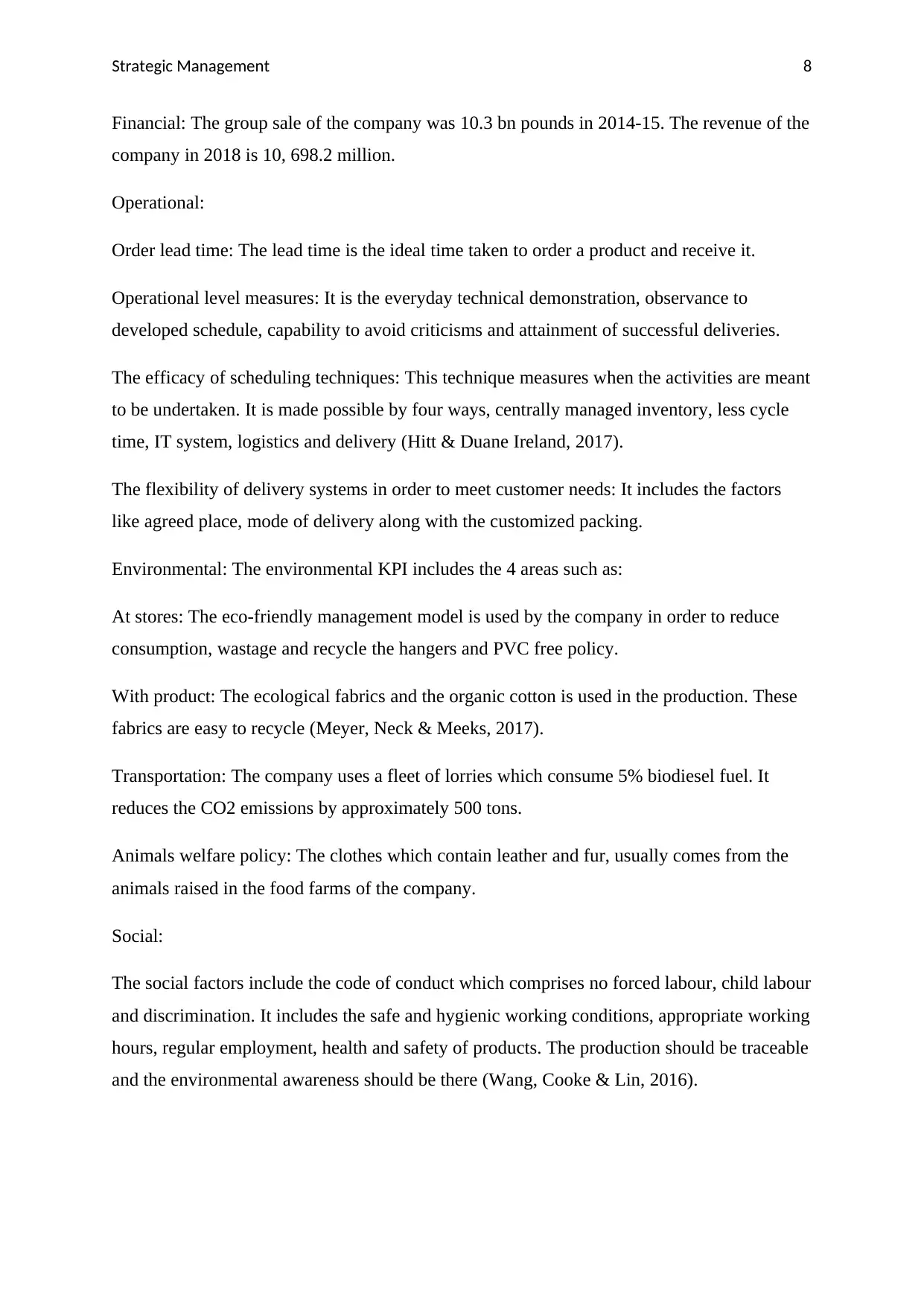
Strategic Management 8
Financial: The group sale of the company was 10.3 bn pounds in 2014-15. The revenue of the
company in 2018 is 10, 698.2 million.
Operational:
Order lead time: The lead time is the ideal time taken to order a product and receive it.
Operational level measures: It is the everyday technical demonstration, observance to
developed schedule, capability to avoid criticisms and attainment of successful deliveries.
The efficacy of scheduling techniques: This technique measures when the activities are meant
to be undertaken. It is made possible by four ways, centrally managed inventory, less cycle
time, IT system, logistics and delivery (Hitt & Duane Ireland, 2017).
The flexibility of delivery systems in order to meet customer needs: It includes the factors
like agreed place, mode of delivery along with the customized packing.
Environmental: The environmental KPI includes the 4 areas such as:
At stores: The eco-friendly management model is used by the company in order to reduce
consumption, wastage and recycle the hangers and PVC free policy.
With product: The ecological fabrics and the organic cotton is used in the production. These
fabrics are easy to recycle (Meyer, Neck & Meeks, 2017).
Transportation: The company uses a fleet of lorries which consume 5% biodiesel fuel. It
reduces the CO2 emissions by approximately 500 tons.
Animals welfare policy: The clothes which contain leather and fur, usually comes from the
animals raised in the food farms of the company.
Social:
The social factors include the code of conduct which comprises no forced labour, child labour
and discrimination. It includes the safe and hygienic working conditions, appropriate working
hours, regular employment, health and safety of products. The production should be traceable
and the environmental awareness should be there (Wang, Cooke & Lin, 2016).
Financial: The group sale of the company was 10.3 bn pounds in 2014-15. The revenue of the
company in 2018 is 10, 698.2 million.
Operational:
Order lead time: The lead time is the ideal time taken to order a product and receive it.
Operational level measures: It is the everyday technical demonstration, observance to
developed schedule, capability to avoid criticisms and attainment of successful deliveries.
The efficacy of scheduling techniques: This technique measures when the activities are meant
to be undertaken. It is made possible by four ways, centrally managed inventory, less cycle
time, IT system, logistics and delivery (Hitt & Duane Ireland, 2017).
The flexibility of delivery systems in order to meet customer needs: It includes the factors
like agreed place, mode of delivery along with the customized packing.
Environmental: The environmental KPI includes the 4 areas such as:
At stores: The eco-friendly management model is used by the company in order to reduce
consumption, wastage and recycle the hangers and PVC free policy.
With product: The ecological fabrics and the organic cotton is used in the production. These
fabrics are easy to recycle (Meyer, Neck & Meeks, 2017).
Transportation: The company uses a fleet of lorries which consume 5% biodiesel fuel. It
reduces the CO2 emissions by approximately 500 tons.
Animals welfare policy: The clothes which contain leather and fur, usually comes from the
animals raised in the food farms of the company.
Social:
The social factors include the code of conduct which comprises no forced labour, child labour
and discrimination. It includes the safe and hygienic working conditions, appropriate working
hours, regular employment, health and safety of products. The production should be traceable
and the environmental awareness should be there (Wang, Cooke & Lin, 2016).
⊘ This is a preview!⊘
Do you want full access?
Subscribe today to unlock all pages.

Trusted by 1+ million students worldwide
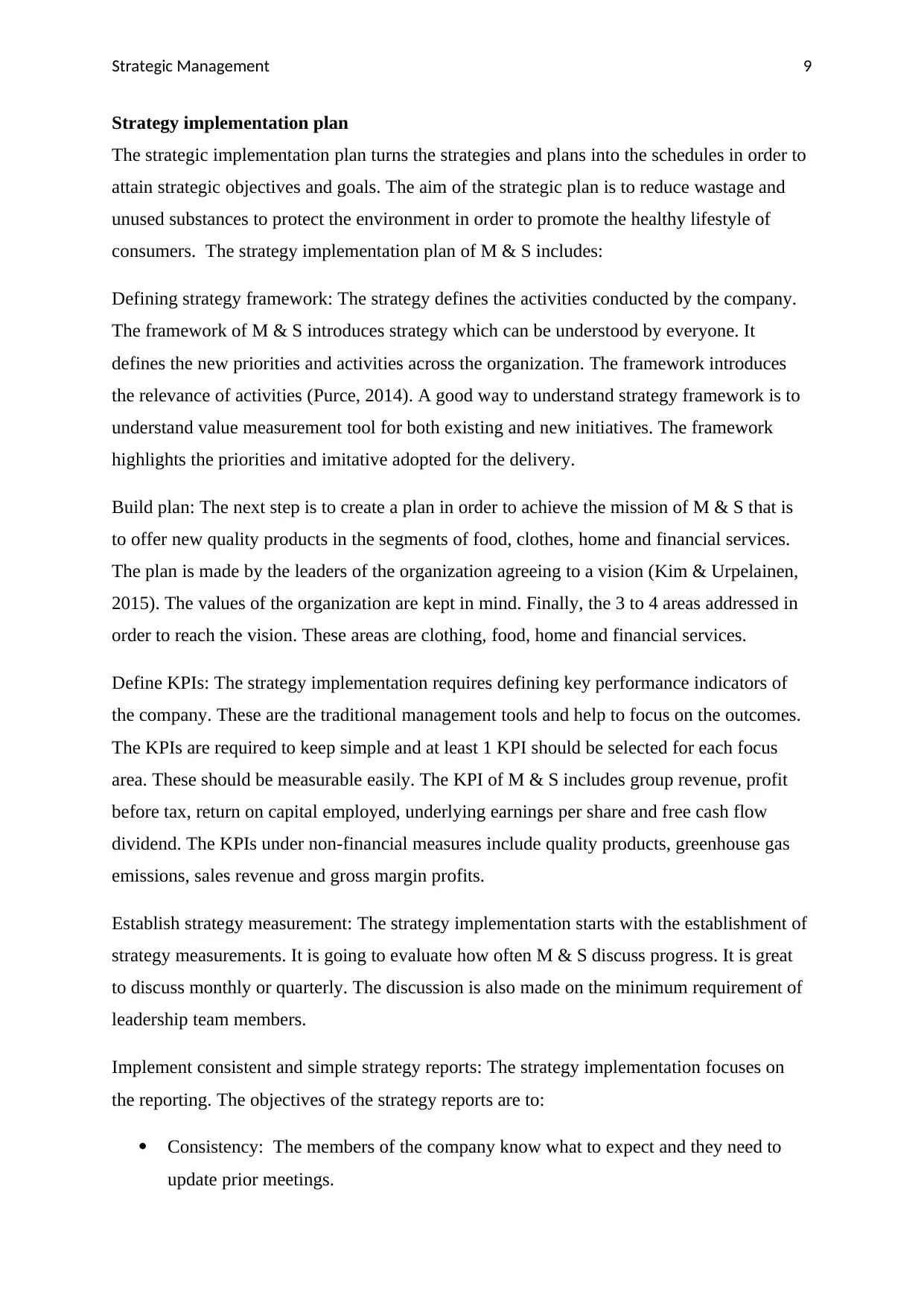
Strategic Management 9
Strategy implementation plan
The strategic implementation plan turns the strategies and plans into the schedules in order to
attain strategic objectives and goals. The aim of the strategic plan is to reduce wastage and
unused substances to protect the environment in order to promote the healthy lifestyle of
consumers. The strategy implementation plan of M & S includes:
Defining strategy framework: The strategy defines the activities conducted by the company.
The framework of M & S introduces strategy which can be understood by everyone. It
defines the new priorities and activities across the organization. The framework introduces
the relevance of activities (Purce, 2014). A good way to understand strategy framework is to
understand value measurement tool for both existing and new initiatives. The framework
highlights the priorities and imitative adopted for the delivery.
Build plan: The next step is to create a plan in order to achieve the mission of M & S that is
to offer new quality products in the segments of food, clothes, home and financial services.
The plan is made by the leaders of the organization agreeing to a vision (Kim & Urpelainen,
2015). The values of the organization are kept in mind. Finally, the 3 to 4 areas addressed in
order to reach the vision. These areas are clothing, food, home and financial services.
Define KPIs: The strategy implementation requires defining key performance indicators of
the company. These are the traditional management tools and help to focus on the outcomes.
The KPIs are required to keep simple and at least 1 KPI should be selected for each focus
area. These should be measurable easily. The KPI of M & S includes group revenue, profit
before tax, return on capital employed, underlying earnings per share and free cash flow
dividend. The KPIs under non-financial measures include quality products, greenhouse gas
emissions, sales revenue and gross margin profits.
Establish strategy measurement: The strategy implementation starts with the establishment of
strategy measurements. It is going to evaluate how often M & S discuss progress. It is great
to discuss monthly or quarterly. The discussion is also made on the minimum requirement of
leadership team members.
Implement consistent and simple strategy reports: The strategy implementation focuses on
the reporting. The objectives of the strategy reports are to:
Consistency: The members of the company know what to expect and they need to
update prior meetings.
Strategy implementation plan
The strategic implementation plan turns the strategies and plans into the schedules in order to
attain strategic objectives and goals. The aim of the strategic plan is to reduce wastage and
unused substances to protect the environment in order to promote the healthy lifestyle of
consumers. The strategy implementation plan of M & S includes:
Defining strategy framework: The strategy defines the activities conducted by the company.
The framework of M & S introduces strategy which can be understood by everyone. It
defines the new priorities and activities across the organization. The framework introduces
the relevance of activities (Purce, 2014). A good way to understand strategy framework is to
understand value measurement tool for both existing and new initiatives. The framework
highlights the priorities and imitative adopted for the delivery.
Build plan: The next step is to create a plan in order to achieve the mission of M & S that is
to offer new quality products in the segments of food, clothes, home and financial services.
The plan is made by the leaders of the organization agreeing to a vision (Kim & Urpelainen,
2015). The values of the organization are kept in mind. Finally, the 3 to 4 areas addressed in
order to reach the vision. These areas are clothing, food, home and financial services.
Define KPIs: The strategy implementation requires defining key performance indicators of
the company. These are the traditional management tools and help to focus on the outcomes.
The KPIs are required to keep simple and at least 1 KPI should be selected for each focus
area. These should be measurable easily. The KPI of M & S includes group revenue, profit
before tax, return on capital employed, underlying earnings per share and free cash flow
dividend. The KPIs under non-financial measures include quality products, greenhouse gas
emissions, sales revenue and gross margin profits.
Establish strategy measurement: The strategy implementation starts with the establishment of
strategy measurements. It is going to evaluate how often M & S discuss progress. It is great
to discuss monthly or quarterly. The discussion is also made on the minimum requirement of
leadership team members.
Implement consistent and simple strategy reports: The strategy implementation focuses on
the reporting. The objectives of the strategy reports are to:
Consistency: The members of the company know what to expect and they need to
update prior meetings.
Paraphrase This Document
Need a fresh take? Get an instant paraphrase of this document with our AI Paraphraser
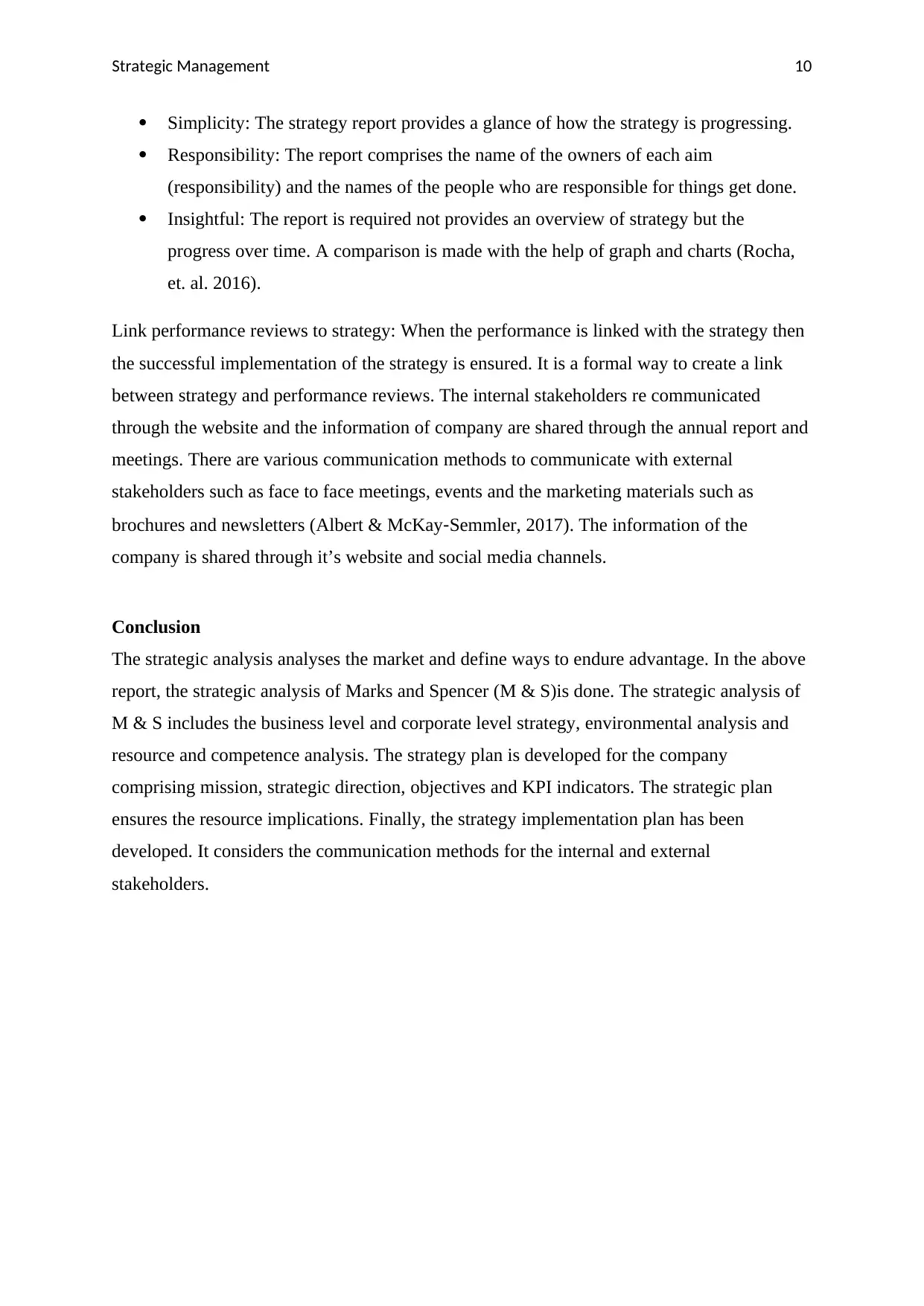
Strategic Management 10
Simplicity: The strategy report provides a glance of how the strategy is progressing.
Responsibility: The report comprises the name of the owners of each aim
(responsibility) and the names of the people who are responsible for things get done.
Insightful: The report is required not provides an overview of strategy but the
progress over time. A comparison is made with the help of graph and charts (Rocha,
et. al. 2016).
Link performance reviews to strategy: When the performance is linked with the strategy then
the successful implementation of the strategy is ensured. It is a formal way to create a link
between strategy and performance reviews. The internal stakeholders re communicated
through the website and the information of company are shared through the annual report and
meetings. There are various communication methods to communicate with external
stakeholders such as face to face meetings, events and the marketing materials such as
brochures and newsletters (Albert & McKay‐Semmler, 2017). The information of the
company is shared through it’s website and social media channels.
Conclusion
The strategic analysis analyses the market and define ways to endure advantage. In the above
report, the strategic analysis of Marks and Spencer (M & S)is done. The strategic analysis of
M & S includes the business level and corporate level strategy, environmental analysis and
resource and competence analysis. The strategy plan is developed for the company
comprising mission, strategic direction, objectives and KPI indicators. The strategic plan
ensures the resource implications. Finally, the strategy implementation plan has been
developed. It considers the communication methods for the internal and external
stakeholders.
Simplicity: The strategy report provides a glance of how the strategy is progressing.
Responsibility: The report comprises the name of the owners of each aim
(responsibility) and the names of the people who are responsible for things get done.
Insightful: The report is required not provides an overview of strategy but the
progress over time. A comparison is made with the help of graph and charts (Rocha,
et. al. 2016).
Link performance reviews to strategy: When the performance is linked with the strategy then
the successful implementation of the strategy is ensured. It is a formal way to create a link
between strategy and performance reviews. The internal stakeholders re communicated
through the website and the information of company are shared through the annual report and
meetings. There are various communication methods to communicate with external
stakeholders such as face to face meetings, events and the marketing materials such as
brochures and newsletters (Albert & McKay‐Semmler, 2017). The information of the
company is shared through it’s website and social media channels.
Conclusion
The strategic analysis analyses the market and define ways to endure advantage. In the above
report, the strategic analysis of Marks and Spencer (M & S)is done. The strategic analysis of
M & S includes the business level and corporate level strategy, environmental analysis and
resource and competence analysis. The strategy plan is developed for the company
comprising mission, strategic direction, objectives and KPI indicators. The strategic plan
ensures the resource implications. Finally, the strategy implementation plan has been
developed. It considers the communication methods for the internal and external
stakeholders.
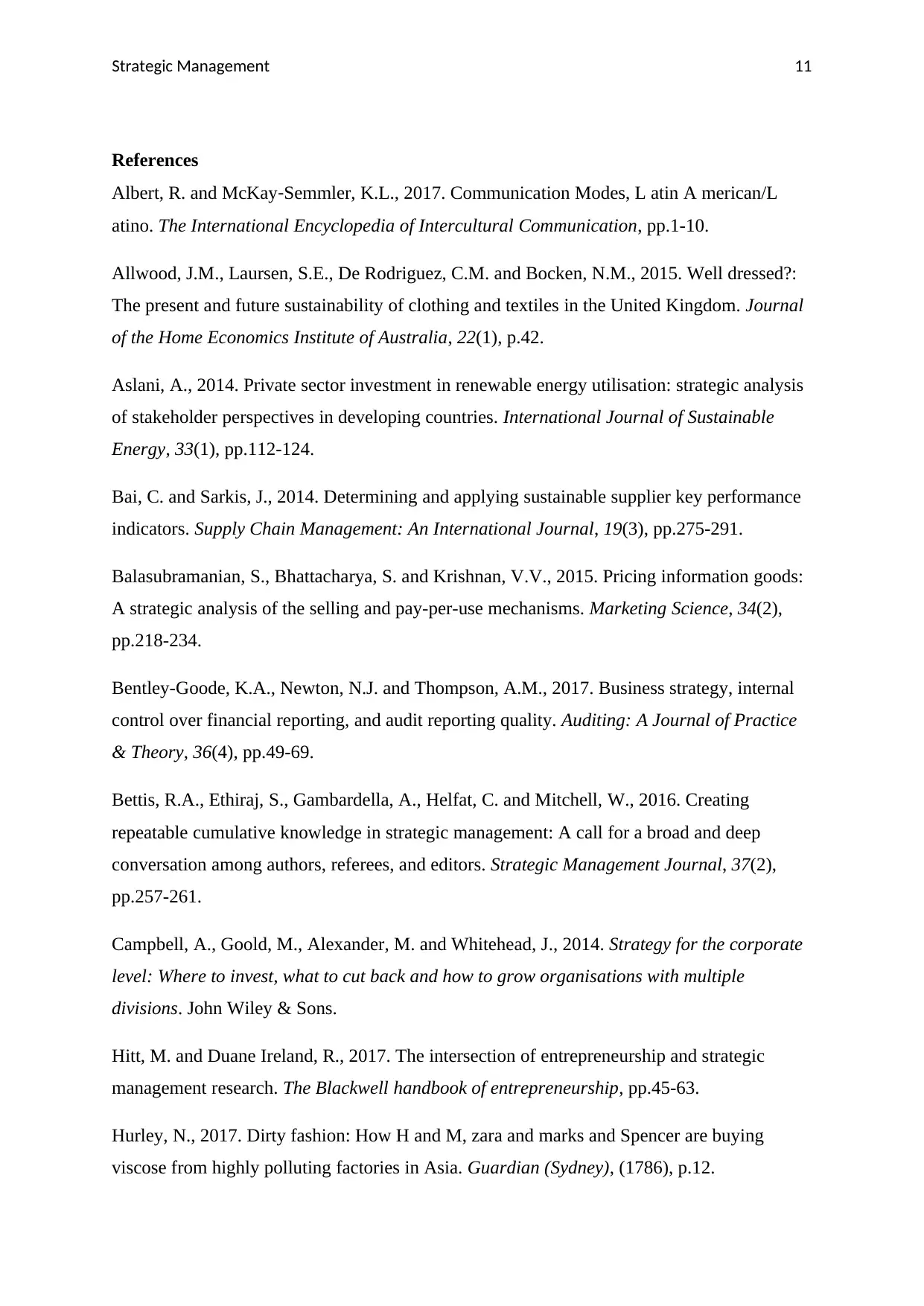
Strategic Management 11
References
Albert, R. and McKay‐Semmler, K.L., 2017. Communication Modes, L atin A merican/L
atino. The International Encyclopedia of Intercultural Communication, pp.1-10.
Allwood, J.M., Laursen, S.E., De Rodriguez, C.M. and Bocken, N.M., 2015. Well dressed?:
The present and future sustainability of clothing and textiles in the United Kingdom. Journal
of the Home Economics Institute of Australia, 22(1), p.42.
Aslani, A., 2014. Private sector investment in renewable energy utilisation: strategic analysis
of stakeholder perspectives in developing countries. International Journal of Sustainable
Energy, 33(1), pp.112-124.
Bai, C. and Sarkis, J., 2014. Determining and applying sustainable supplier key performance
indicators. Supply Chain Management: An International Journal, 19(3), pp.275-291.
Balasubramanian, S., Bhattacharya, S. and Krishnan, V.V., 2015. Pricing information goods:
A strategic analysis of the selling and pay-per-use mechanisms. Marketing Science, 34(2),
pp.218-234.
Bentley-Goode, K.A., Newton, N.J. and Thompson, A.M., 2017. Business strategy, internal
control over financial reporting, and audit reporting quality. Auditing: A Journal of Practice
& Theory, 36(4), pp.49-69.
Bettis, R.A., Ethiraj, S., Gambardella, A., Helfat, C. and Mitchell, W., 2016. Creating
repeatable cumulative knowledge in strategic management: A call for a broad and deep
conversation among authors, referees, and editors. Strategic Management Journal, 37(2),
pp.257-261.
Campbell, A., Goold, M., Alexander, M. and Whitehead, J., 2014. Strategy for the corporate
level: Where to invest, what to cut back and how to grow organisations with multiple
divisions. John Wiley & Sons.
Hitt, M. and Duane Ireland, R., 2017. The intersection of entrepreneurship and strategic
management research. The Blackwell handbook of entrepreneurship, pp.45-63.
Hurley, N., 2017. Dirty fashion: How H and M, zara and marks and Spencer are buying
viscose from highly polluting factories in Asia. Guardian (Sydney), (1786), p.12.
References
Albert, R. and McKay‐Semmler, K.L., 2017. Communication Modes, L atin A merican/L
atino. The International Encyclopedia of Intercultural Communication, pp.1-10.
Allwood, J.M., Laursen, S.E., De Rodriguez, C.M. and Bocken, N.M., 2015. Well dressed?:
The present and future sustainability of clothing and textiles in the United Kingdom. Journal
of the Home Economics Institute of Australia, 22(1), p.42.
Aslani, A., 2014. Private sector investment in renewable energy utilisation: strategic analysis
of stakeholder perspectives in developing countries. International Journal of Sustainable
Energy, 33(1), pp.112-124.
Bai, C. and Sarkis, J., 2014. Determining and applying sustainable supplier key performance
indicators. Supply Chain Management: An International Journal, 19(3), pp.275-291.
Balasubramanian, S., Bhattacharya, S. and Krishnan, V.V., 2015. Pricing information goods:
A strategic analysis of the selling and pay-per-use mechanisms. Marketing Science, 34(2),
pp.218-234.
Bentley-Goode, K.A., Newton, N.J. and Thompson, A.M., 2017. Business strategy, internal
control over financial reporting, and audit reporting quality. Auditing: A Journal of Practice
& Theory, 36(4), pp.49-69.
Bettis, R.A., Ethiraj, S., Gambardella, A., Helfat, C. and Mitchell, W., 2016. Creating
repeatable cumulative knowledge in strategic management: A call for a broad and deep
conversation among authors, referees, and editors. Strategic Management Journal, 37(2),
pp.257-261.
Campbell, A., Goold, M., Alexander, M. and Whitehead, J., 2014. Strategy for the corporate
level: Where to invest, what to cut back and how to grow organisations with multiple
divisions. John Wiley & Sons.
Hitt, M. and Duane Ireland, R., 2017. The intersection of entrepreneurship and strategic
management research. The Blackwell handbook of entrepreneurship, pp.45-63.
Hurley, N., 2017. Dirty fashion: How H and M, zara and marks and Spencer are buying
viscose from highly polluting factories in Asia. Guardian (Sydney), (1786), p.12.
⊘ This is a preview!⊘
Do you want full access?
Subscribe today to unlock all pages.

Trusted by 1+ million students worldwide
1 out of 14
Related Documents
Your All-in-One AI-Powered Toolkit for Academic Success.
+13062052269
info@desklib.com
Available 24*7 on WhatsApp / Email
![[object Object]](/_next/static/media/star-bottom.7253800d.svg)
Unlock your academic potential
Copyright © 2020–2025 A2Z Services. All Rights Reserved. Developed and managed by ZUCOL.




